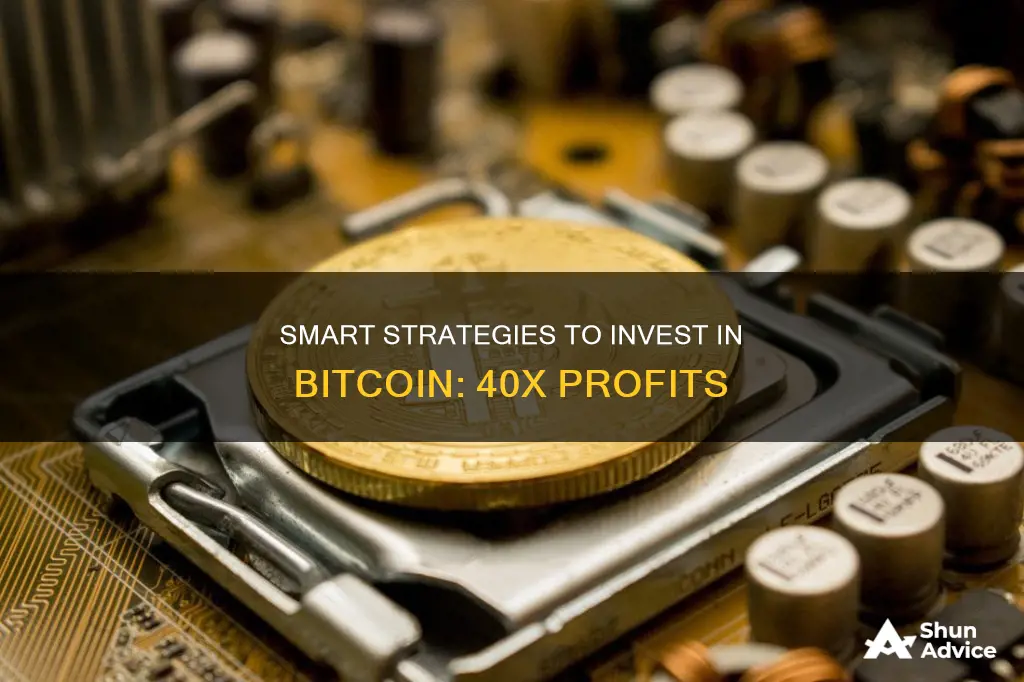
Bitcoin is a cryptocurrency, a virtual currency that can be used as money and a form of payment outside the control of any one person, group, or entity. It is a highly volatile asset that's prone to large and fast swings in value, which presents an opportunity for large returns but also poses tremendous risk. Here's a beginner's guide on how to invest in Bitcoin:
- Join a Bitcoin Exchange: Most Bitcoin investors use cryptocurrency exchanges, which act as middlemen for cryptocurrency investing, similar to a stock brokerage. Popular options include Coinbase, Binance, Kraken, Gemini, and Bitfinex.
- Get a Bitcoin Wallet: When you purchase a coin, it's stored in a wallet. There are two types of wallets: a hot wallet, which is operated by your cryptocurrency exchange or provider, and a cold wallet, an actual piece of hardware that stores your coins.
- Connect Your Wallet to a Bank Account: Link your wallet to your bank account to enable you to purchase and sell coins. Alternatively, you can link your bank account directly to your cryptocurrency exchange account.
- Place Your Bitcoin Order: Determine how much Bitcoin you want to purchase. Some coins cost thousands of dollars, but exchanges often allow you to buy fractions of a single coin, with an initial investment as low as $25.
- Manage Your Bitcoin Investments: After buying Bitcoin, you can use your coins for online transactions, hold them long-term, or perform day trading. Your cryptocurrency exchange will provide the tools needed to buy and sell coins.
| Characteristics | Values |
|---|---|
| What is Bitcoin? | A cryptocurrency (a virtual currency) designed to act as money and a form of payment outside the control of any one person, group, or entity. |
| Who started Bitcoin? | Satoshi Nakamoto is a pseudonym for the person—or people—who created Bitcoin. |
| How does Bitcoin work? | Bitcoin transactions are verified by crypto miners via a proof of work consensus mechanism. |
| How to buy Bitcoin? | You can buy bitcoin on Coinbase by creating and funding an account using your bank account, credit card, or debit card. |
| How much should you buy? | Experts generally agree that cryptocurrencies shouldn’t make up more than 5% of your portfolio. |
| How to store your Bitcoins? | Hardware wallets, offline storage, software wallets, crypto exchanges. |
What You'll Learn

Choosing a Bitcoin exchange
Crypto exchanges are your gateway to the cryptocurrency market. There are hundreds of cryptocurrency exchanges available to traders and investors, so making the right choice is crucial. Here are some factors to consider when choosing a Bitcoin exchange:
- Authenticity and security: Research the exchange to ensure it is a legitimate and secure platform. Check its reputation and the security protocols they have in place to protect your data and funds.
- Payment methods: Different platforms support different payment methods, such as bank transfers, PayPal, credit cards, and debit cards. Choose an exchange that offers a payment method that suits your needs. If you are a beginner, select a platform that accepts fiat currency to make the process less stressful.
- Supported coins and tokens: While most exchanges support Bitcoin and Ethereum, there are thousands of other cryptocurrencies. Choose an exchange that offers a wide range of coins and tokens, such as Binance, if you want exposure to a diverse range of cryptocurrencies.
- Transaction fees: Understand the fee structure of each exchange, as fees can vary significantly. Look for an exchange with transparent and competitive fees, and avoid platforms with hidden transaction fees.
- User interface and experience: Choose an exchange with an intuitive interface and a good user experience, making it easier to trade cryptocurrencies. Also, consider the customer service and other customer-related functionalities offered by the exchange.
Some of the leading cryptocurrency exchanges include Binance, Coinbase, Kraken, and Crypto.com. These platforms offer a wide range of features, including a large number of supported cryptocurrencies, advanced trading options, and strong security measures.
Protecting Your Bitcoin Investment: Strategies to Mitigate Risks
You may want to see also

Getting a Bitcoin wallet
To get started with investing in Bitcoin, you'll need to get a Bitcoin wallet to store your cryptocurrency. Setting up a Bitcoin wallet is as easy as installing an app on your mobile device or laptop/desktop.
There are several types of Bitcoin wallets, each with its own pros and cons. Here are some of the most common types:
Hosted Wallets
Hosted wallets are the most popular and easy-to-set-up type of crypto wallet. When you buy crypto using an app like Coinbase, your crypto is automatically held in a hosted wallet. It's called "hosted" because a third party, like a bank, keeps your crypto for you. The main benefit of a hosted wallet is that if you forget your password, you won't lose your crypto. However, a drawback is that hosted wallets don't currently support all crypto features.
Non-Custodial Wallets (Self-Custody Wallets)
A non-custodial wallet, like the Coinbase Wallet, puts you in complete control of your crypto. With this type of wallet, you don't rely on a third party to keep your crypto safe. While the wallet provider supplies the software to store your crypto, the responsibility of remembering and safeguarding your password falls entirely on you. If you lose or forget your password, there's no way to access your crypto. Non-custodial wallets also allow you to access more advanced crypto activities like yield farming, staking, lending, and borrowing.
Hardware Wallets
A hardware wallet is a physical device, about the size of a thumb drive, that stores your private keys offline. Hardware wallets are considered one of the most secure ways to store your crypto, but they are more complex and costly than other types of wallets. They are also less convenient to use compared to software wallets.
When choosing a Bitcoin wallet, it's important to consider your needs and preferences. Factors to consider include security, ease of use, compliance with regulations, cost, and the level of control you want over your crypto. Additionally, make sure to use a strong password and enable two-factor authentication for added security.
Calculating Bitcoin Profits: A Guide to Investment Gains
You may want to see also

Connecting your wallet to a bank account
Step 1: Navigate to the "Add Account" Screen
On the All Accounts screen, click on the "Add Account" box in the list of accounts. If you are using a mobile device, swipe left on your dashboard until you reach the end of your accounts. Swipe left once more to access the "Add Account" screen.
Step 2: Select "Bank Sync"
To add a bank-connected account, choose the "Bank Sync" option.
Step 3: Search for Your Bank
Type in the name and country of your bank in the search field. If you cannot find your bank, you may need to submit a request for it to be added.
Step 4: Choose Your Banking Portal
Select your banking portal from the drop-down options.
Step 5: Enter Your Login Credentials
Enter the login credentials you use to access your bank's website. Depending on your bank, you may need to answer additional security questions.
Step 6: Choose Your Account
Select the specific account you want to connect from the provided options.
Connecting your wallet to your bank account is a simple process, but it is important to ensure that your login credentials are correct and that you have all the necessary information before beginning the process.
Smart Ways to Invest $20 in Bitcoin
You may want to see also

Placing your first order
Step 1: Choose a Crypto Exchange
First, you'll need to select a cryptocurrency exchange that suits your needs. Popular options include Coinbase, Kraken, Gemini, and Binance, but there are many others to choose from. These exchanges allow you to buy, sell, and hold Bitcoin and other cryptocurrencies. When creating your account, be sure to use a strong password and enable two-factor authentication for added security.
Step 2: Connect a Payment Method
The next step is to connect your exchange account to a payment method. You can typically use a bank account, debit card, or credit card for this. Keep in mind that using a credit card may incur additional fees and interest charges. Some exchanges may also require you to provide personal identification information, such as a driver's license or Social Security card.
Step 3: Place Your First Order
Now comes the exciting part—placing your first Bitcoin order! Specify the amount of Bitcoin you want to buy, being mindful of your budget and the volatility of the cryptocurrency market. You can choose from various order types, including market orders, limit orders, and stop orders, each with its own advantages and disadvantages. A market order is the simplest option and will execute immediately at the current market price. Limit orders allow you to set a specific price you want to buy or sell at, but they may not be filled if the market doesn't reach your target price. Stop orders are useful for minimising losses if the price of Bitcoin drops.
Step 4: Safe Storage
Once you've placed your order, it's crucial to ensure the safe storage of your Bitcoin. You can choose between hot wallets and cold wallets. Hot wallets are online wallets provided by exchanges or third-party providers, which offer faster transactions but may be more vulnerable to security breaches. Cold wallets, on the other hand, are offline devices that provide greater security but may be less convenient for frequent trading.
Remember to always do your research, start with small investments, and never invest more than you can afford to lose. Good luck with your first Bitcoin order!
Smart Bitcoin Investment: How Much to Invest?
You may want to see also

Managing your investments
Once you've purchased your Bitcoin, you'll need to decide what to do with it. Here are some options for managing your Bitcoin investments:
- Use your coins to make online transactions.
- Hold your coins for the long term in the hopes that their value will increase.
- Perform day trading with your coins by buying and selling with other Bitcoin owners, which can be facilitated on a cryptocurrency exchange.
- Use your Bitcoin to make purchases at retailers and merchants that accept it as a form of payment.
It's important to keep in mind that Bitcoin is a very high-risk and volatile investment. Its value may rise or fall dramatically in a very short period, even within a few hours or days. As such, it's crucial to carefully consider your risk tolerance, investment strategy, and financial goals before investing in Bitcoin.
Institutional Bitcoin Adoption: Who's In and Why?
You may want to see also
Frequently asked questions
You will need personal identification documents, bank account information, and a secure internet connection.
You can invest in Bitcoin in five steps: join a Bitcoin exchange, get a Bitcoin wallet, connect your wallet to a bank account, place your Bitcoin order, and manage your Bitcoin investments.
No investment is inherently "good" or "bad." It depends on your risk tolerance, investment strategy, and financial goals. Bitcoin is a very high-risk investment because it is a volatile asset.
The main benefit of investing in Bitcoin is that you may be able to generate a huge return on profit, perhaps as high as 200% or more. However, the high volatility of Bitcoin also makes it a hazardous investment, and you could lose money if you're not careful.







